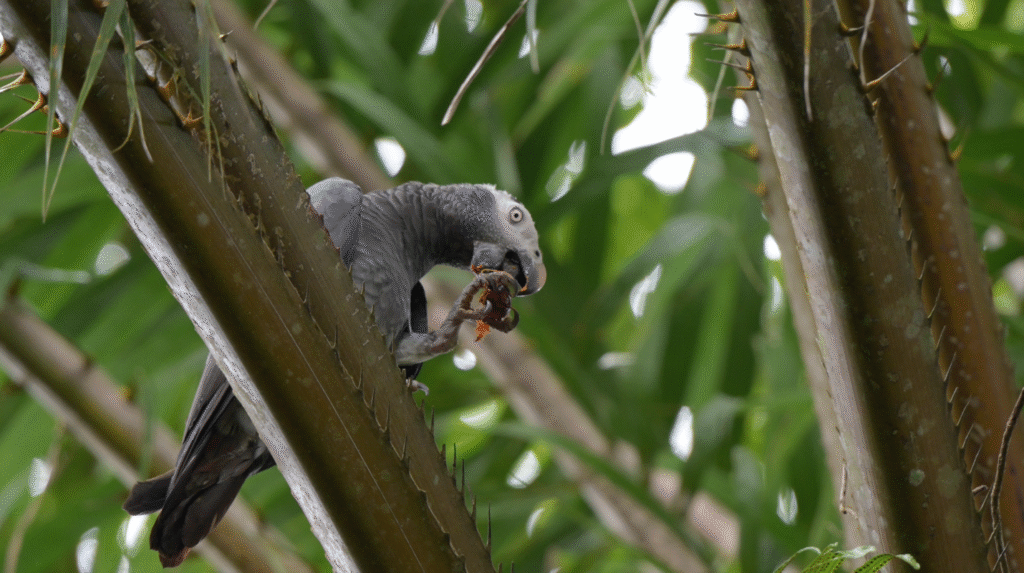Location undisclosed — Fourteen Timneh parrots lastly obtained their freedom again on July eighth, 2025. And this time freedom tasted a little bit like palm fruit. The rehabilitated parrots have been launched in an space with a wholesome inhabitants of untamed parrots.
By Sanshey Biswas and Manon Verchot
Timneh parrots are massive, grey parrots with brick-red coloured tails. The Worldwide Union for Conservation of Nature, an organisation that tracks the chance of extinction of species world wide, lists these birds as endangered. Conservationists consider that there are between 100,000 and 500,000 of those birds left within the wild, and the numbers are lowering. The principle threats they face are shedding habitat from actions like logging or being captured for the pet commerce.
“Most individuals discover an curiosity in preserving them for the character and never for the meat,” mentioned T. Benjamin Tehn, animal caretaker at Libassa Wildlife Sanctuary.

Since 2016, the looking and buying and selling of protected animals has been forbidden by Liberia’s Nationwide Wildlife Conservation and Protected Space Administration Legislation. Beneath this regulation, hunters and merchants threat being fined and jailed when they’re caught with protected wildlife. Any animals they’ve with them — useless or alive — are confiscated by the Forestry Improvement Authority (FDA).
For years, the FDA has handed over confiscated Timneh parrots to the group on the Libassa Wildlife Sanctuary, Liberia’s solely wildlife rescue middle for a number of species. The sanctuary has a group of animal carers and a veterinarian who’re skilled to look after animals till they’re able to return to the wild.
“We obtain a variety of injured animals,” mentioned Juty Deh, Jr., supervisor of the Libassa Wildlife Sanctuary. “So you can’t launch the animal except you already know that the animal is unbiased and you already know that it might probably do the whole lot by itself.”
Within the case of the Timneh parrots, the discharge course of was years within the making. Most of the parrots dropped at the sanctuary had their feathers clipped, so new feathers needed to develop in earlier than the birds would be capable to fly. The group additionally examined and handled the birds for any ailments they may have.
“We needed to guarantee that we’re not introducing ailments into the wild inhabitants of parrots,” mentioned Manon Dorny, veterinarian at Libassa Wildlife Sanctuary. “Now [the rescued parrots] are all tremendous wholesome, they’re doing nice.”
As soon as the parrots got a clear invoice of well being, plans for his or her launch concerned cautious coordination between groups on the sanctuary, the FDA and World Parrot Belief. Discovering a launch web site the place the parrots would have sufficient meals and the place there can be little threat of them being killed or captured once more was a precedence.

Andrew N. Gweh, a conservationist who research birds throughout Liberia, helped establish a launch web site in a small village within the coronary heart of Liberia. Gweh had noticed a big inhabitants of untamed Timneh parrots within the area, which informed him that this might be a very good location for the discharge. For the safety of the parrots, the situation will not be being disclosed.
Releasing wild animals isn’t as straightforward as opening a cage door. Getting consent from the neighborhood is the important thing for a profitable conservation challenge, Gweh informed FrontPage Africa. “It can be sure in our absence, in our presence, the appropriate factor shall be finished,” he mentioned.
With the neighborhood’s permission, the parrots have been launched. And the very first thing the birds did as they flew out of their cages, was to snack on some wild palm fruit.

